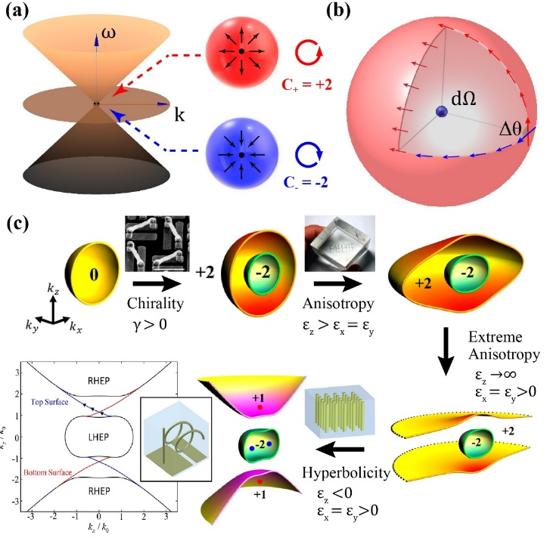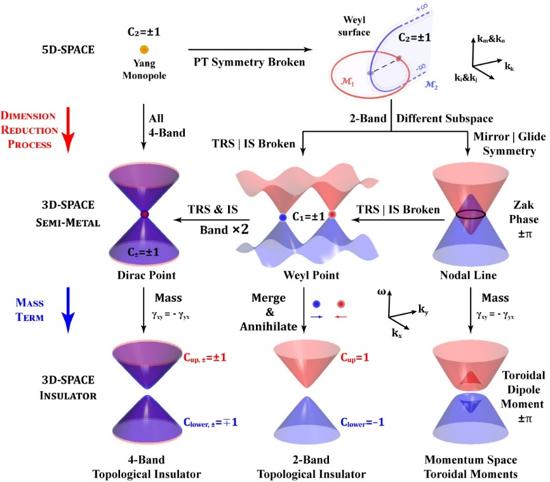In mathematics, topology is concerned with the properties of a geometric object that are preserved under continuous deformations. In physics, topology is generally manifested in the evolution of the eigenstates. With the celebrated quantum Hall effect introducing topological Chern invariants into physical systems for the first time, interesting phenomena based on topology have been vigorously developed in various fields of physics.
Topological photonics further extends the field of topological research from condensed matter systems to classical wave systems, which brings hope for new devices and applications, such as topological quantum computing and topological lasers. The 2016 Nobel Prize in Physics was awarded to the field of topological physics in response to the broad influence of topological phases in physics.
Recently, a team of scientists led by Prof. Shuang Zhang at the University of Hong Kong, was invited by Co-Editors-in-Chief to contribute a comprehensive review paper entitled " Topological photonics in metamaterials ", which was published in the first issue of Photonics Insights. (Shaojie Ma, Biao Yang, Shuang Zhang. Topological photonics in metamaterials[J]. Photonics Insights, 2022, 1(1): R02).
The authors reviewed the latest developments in topological photonics, especially the topological realization based on three dimensional electromagnetic metamaterials. Through artificially designed resonant units, metamaterials provide vast degrees of freedom for realizing various topological states, such as Weyl points, nodal lines, Dirac points, topological insulators, and even Yang monopole and Weyl surfaces that exist only in higher-dimensional synthetic spaces. These special topological responses further endow metamaterials with special optical responses and optical control capabilities.
Based on a simple RLC model, this article discusses the relationship between electromagnetic constitutive relation, metamaterial design, and topological state through effective medium model theory. Furthermore, by discussing topological states in different symmetries and dimensions, this article systematically analyzes the possibility of mutual transformation between different topological systems, as well as the differences in electromagnetic responses and metamaterial designs of different topological phases.
Intrinsic Topological Properties of Electromagnetic Systems
Near the degenerate points, the local response of a system can be the same as a specific low-energy effective Hamiltonian, resulting in a special topological response, such as Weyl points, nodal lines, Dirac points, etc., as well as the corresponding bulk-boundary correspondence.

Fig. 1 Intrinsic topological properties of electromagnetic systems
Taking the simplest vacuum as an example, considering the eigenfrequencies including the negative ones, the dispersion behavior of Maxwell's equation near zero point constitutes two sets of independent third-order degenerate subsystems. Such systems exhibit spin-1 quasiparticle characteristics, where LCP/RCP experience opposite topological charges ±1.
This is the intrinsic topological property of an electromagnetic system. However, in general, LCP and RCP with opposite topological charges are degenerate, so the system as a whole does not have any topological characteristics. Through adding specific electromagnetic resonance units to gradually introduce chirality and hyperbolic dispersion features into the system, the metamaterial can separate the iso-frequency surfaces of LCP/RCP eigenstates in the momentum space. Thereby, this metamaterial becomes a topologically nontrivial electromagnetic system, and a topologically protected one-way surface states will occurs on the boundary.
The concept of such a low-energy effective Hamiltonian can be further expanded. Based on the huge degrees of freedom provided by the electromagnetic constitutive relation of metamaterials, various topological states with different symmetries and different dimensions can be realized.

Fig. 2 Illustration of the topological phase transition by introducing/breaking specific symmetries or by considering a dimension reduction process.
Symmetry-Controlled Topological Transitions
Following a specific symmetry and adjusting the strength and direction of the electromagnetic resonances, one can achieve specific electromagnetic resonances along a typical direction, as well as symmetrical bi-anisotropic terms. Such a metamaterial can be an ideal Weyl system, that is, only topological Weyl points with Chern number and no any other modes exists at a specific frequency. This system can be a perfect platform to display unique features of Weyl points, such as the helical surface states, chiral anomalies, etc.
Starting from this Weyl system, by introducing additional symmetry to cancel the bi-anisotropic terms, the Weyl system can be transformed into a nodal line system, and exhibit the corresponding drumhead surface states. Similarly, starting from the nodal line system protected by spatial symmetry, introducing a magnetic field to break the time-reversal symmetry can also transform the system from a nodal line system back into a Weyl system. By controlling the symmetry of a metamaterial system, the topological states can be transformed from one to another.
Dimension-Controlled Topological Transitions
Metamaterials can also be used to achieve three-dimensional Dirac points by adjusting the frequency of resonance to achieve electromagnetic duality symmetry, through a suitable combination of electromagnetic resonance units. By introducing antisymmetric bi-anisotropic terms as two synthetic dimensions, the Dirac point in such a three-dimensional metamaterial can be further extended to a five-dimensional Yang monopole or a five-dimensional linked Weyl surface. This system has the high-dimensional and high-order topological behaviors and the corresponding high-order surface state characteristics, such as Weyl arcs.
Starting from such a high-dimensional topological structure, a series of low-dimensional topological semi-metal and topological insulator states can be achieved, through special dimension reduction processes. For example, four-dimensional and three-dimensional topological insulators can be realized by dimension reduction from a five-dimensional Yang monopole, and the three-dimensional toroidal momentum can be obtained from a five-dimensional Weyl surface, etc. By controlling the dimensions of the metamaterial system, the topological states can also be transformed from one to another.
Conclusion and Perspectives
Professor Zhang's team and their collaborators have summarized and discussed in detail the theoretical and experimental realization of the metamaterial-based topological photonics. As an excellent platform, electromagnetic metamaterials endow huge degrees of freedom to realize special topological states, and the discussions based on topological physics also guide the design of metamaterials to achieve special electromagnetic responses. Similar ideas can be further extended to elastic wave systems, and to guide new device designs, or use metamaterial platforms to explore more exotic physical phenomena by combining ideas such as synthetic dimensions, non-Hermitian, and higher-order topologies.


